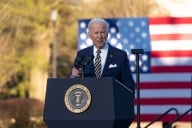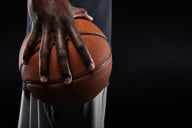You have /5 articles left.
Sign up for a free account or log in.
From the protests at the University of Missouri over racial representation to the women’s volleyball team at West Virginia University Institute of Technology declining to stand during the national anthem, college athletes have embraced a renewed role in campus activism in recent years.
It may come in the form of a football team threatening to boycott a game over racial inequality or a quarterback posting a photo of himself online wearing a hat emblazoned with the words “Fuck Trump.” Either way, such protests often spark debates about free speech, with colleges and teams caught in the middle. That debate was a common theme at last month’s National Collegiate Athletic Association meeting in Nashville, Tenn., with college presidents, athletes and NCAA leaders all weighing in on the topic.
The consensus: let the players speak.
“From the Vietnam War to the present, student-athletes have felt compelled to use their platform to express opinions about social issues,” Kevin Rome, president of Lincoln University, said during a panel discussion at the meeting. “Whether by wearing black armbands or kneeling during the national anthem, student athletes should not lose their constitutional rights.”
When Tim Wolfe announced his resignation as the University of Missouri System’s president in November 2015, the decision came after weeks of demonstrations over the president’s handling of a string of racist incidents on campus. Student and faculty groups had been calling for Wolfe’s resignation, and a graduate student went on a weeklong hunger strike, vowing he would not eat until Wolfe was “removed from office or my internal organs fail and my life is lost.”
Then at least 30 members of the university’s football team linked arms with the hunger striker and gave an ultimatum: if Wolfe didn’t resign, they would boycott all football-related activities.
That included a game scheduled just days later. While it would be an exaggeration to attribute Wolfe's resignation -- and that of the Columbia campus's chancellor, R. Bowen Loftin -- largely to the players' actions, their well-publicized strike certainly helped tip the scales and highlighted what kind of economic power athletes hold. At a meeting of the Knight Commission on Intercollegiate Athletics in May, Arne Duncan, a former U.S. secretary of education, asked if college players would consider organizing similar boycotts over athletics issues like concussion policies or name, image and likeness rights.
Rollins Stallworth, a former Stanford University football player and chair of the Pac-12 Conference’s Student-Athlete Advisory Committee, revealed that two of Stanford’s team captains boycotted football-related activities in 2015 during summer workouts after the university was late in providing players with scholarship money for participating in the camp. The protest was not nearly as dramatic as the strike at Missouri, Stallworth said, but “seeing the effect of two of our teammates doing that and what goes on in the locker room, the discussion that happens, you can see the potential that could happen.”
During the NCAA’s annual meeting last month, the chair of the Division I Board of Directors and the chairs of the Division II and Division III Presidents Councils all said they supported athlete protests and activism, particularly those involving social justice issues.
“Athletes have a prominent role,” said Alan Cureton, chair of the Division III Presidents Council. “On the 10 o’ clock news, it’s news, weather and sports. Not news, weather and opera. Athletes have a platform. We have an opportunity to be a voice for those who do not have a voice. We have an opportunity to speak up for those who can’t speak up. The platform allows athletes to say, ‘This is what I believe in.’”
That stance isn’t shared by everyone. Critics of the protest at Missouri were so worried that similar boycott attempts would take place elsewhere in the state that one Missouri lawmaker introduced legislation that would have stripped athletes of their scholarships if they boycotted games. Last year, a state senator placed a hold on the University of Arkansas' budget request after six members of the women's basketball team knelt during the national anthem to protest police shootings of African-Americans.
In August, Jim Mora, head football coach at the University of California, Los Angeles, publicly admonished his quarterback for wearing the “Fuck Trump” hat. When asked by a reporter how he would handle one of his players protesting racial inequality by not standing during the national anthem, Clemson University's head football coach, Dabo Swinney, criticized athletes who do not stand for the anthem and said, “Some of these people need to move to another country.”
Speaking at the NCAA meeting, Rome, of Lincoln University, was critical of such responses. “Restrictive policies are not the answer,” he said. “Sometimes the answer is to just not make an issue out of it.”
College sports reformers, meanwhile, have been encouraged by the protests and have said a boycott of a bowl game -- which are typically among the most watched and most lucrative games in a program's season -- would be one of the most impactful ways athletes could protest their treatment or take a stand for social justice issues. They seemingly got their wish in December, when the University of Minnesota football team said it would boycott the Holiday Bowl.
The focus of the protest, however, was not exactly what the reformers had in mind.
The Minnesota players were angry not over racial inequality or athlete safety, but over the suspension of 10 teammates who had been accused of sexually assaulting and harassing a female student. The university had conducted an investigation finding many of the charges to be valid. The athletes argued that the university had violated their teammates' rights to due process. The team’s head coach, Tracy Claeys, posted a message on Twitter supporting his players.
The boycott initially attracted sympathy from many alumni and those concerned about issues of due process, but support for the university's stance grew as details emerged about what happened to the female student, in particular after a redacted version of the university's equal opportunity office's report on its investigation was published online.
The report detailed why the university found that four of the players engaged in sexual assault and that others engaged in forms of harassment, such as videotaping the victim without her consent. The report also stated that some athletes tried to cover up what happened or violated other parts of the student code of conduct.
After the report was leaked, the players ended the boycott. The university fired Claeys, the head coach, two weeks later.
Kendall Spencer, a former college track athlete and the first student member of the NCAA’s Division I Board of Directors, said protests of that nature can be avoided if athletes feel as though they have a clear way of communicating their frustrations to an institution. Spencer said athletes too often feel they cannot voice their concerns with coaches and administrators, leaving colleges caught off guard when a team goes public with an issue.
When the football team at Northwestern University decided to unionize in 2014, Spencer said, the university’s student-athlete advisory committee told him that it “had no idea the football team even had a problem” until the unionization efforts went public.
“When people don’t communicate, it’s a free-for-all,” Spencer said. “And then you have to end up cleaning up house when someone has an issue and they go straight to the media. It begs the question: What kind of vehicles are we providing to student-athletes to have these kinds of conversations?”








